Throughout the spring and summer of 1889, the Pueblo City Council members were busy preparing to upgrade to a paid fire department. Instead of the hand pulled hose carts, the new department would use horse-drawn wagons, and a new horse-drawn hook and ladder truck. They also made plans to purchase two horse drawn steamers, though they ended up getting only one initially. Chief Robert J. Krague was the chief of the volunteer department, who still provided the fire protection in the growing city. Chief Krague worked with the City Council in getting prices on the various equipment. They decided on a steamer engine from the Ahrens Co, a size 2 piston pump costing $4,000 that arrived in September. They also got bids from the Silsby Co. and the LaFrance Co. for a steamer. The two hose wagons and the hook and ladder truck were purchased from the E. P. Preston Co. of Chicago, and arrived in Pueblo on July 29th. The hose wagons cost $1,200 apiece without hose or nozzles, and the aerial ladder truck was $3,150 including a full compliment of ground ladders.
On October 1st, 1889, the fire department officially became a professional department, under the guidance of Fire Chief Robert J. Krague and Asst. Fire Chief Tris D. Sanborn. The fire department headquarters was in City Hall at 123 Central Main St. The city had also established a very good water supply system with over 40 fire hydrants and 24 Gamewell Fire Alarm Boxes around town. The telegraph-based Gamewell boxes notified the base station at the water works building, and a steam whistle would sound the box number. However, the boxes were 7 years old and would short circuit each other if more than one box were pulled at the same time. Chief Krague recommended upgrading the Gamewell boxes to non-interfering ones, though The Pueblo Chieftain was backing the new telephone system. The Gamewell boxes would continue being used until 1980.
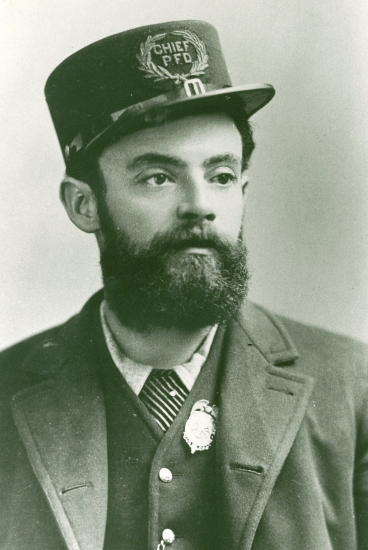
Fire Chief Robert J. Krague.
They also purchased horses, which several aldermen went on trips to Denver, Kansas City, and St. Louis to find them. They purchased two gray horses from Denver to pull the James Rice Hose Co. No. 1, which was the name of the original hose company of Pueblo Volunteer Fire Dept. in 1874. They named the horses after Aldermen "Jack" Hogan and "Tom" Lloyd. The Rice Hose Co. No. 1 was housed in the old Pueblo City Hall building at 616 N. Main St. The paid fireman for the Rice Co. were Captain George W. Hook, who would become the third chief of the department, Driver A. E. Neagle, and Firemen Frank Smith and William Corbert.
The hook and ladder company was called the A. A. Grome Hook & Ladder Co. No. 1, named after Alderman A. A. Grome. The bay horses came from Kansas City, weighed 1,400 pounds apiece and were named after Aldermen "A. T." Stewart and "George" Alden. The paid firemen for the H. & L. Co. were Captain Clarence Patterson, Driver George S. Bailey, Tillerman Jack Dawson, and Firemen John Campbell and I. Reed.
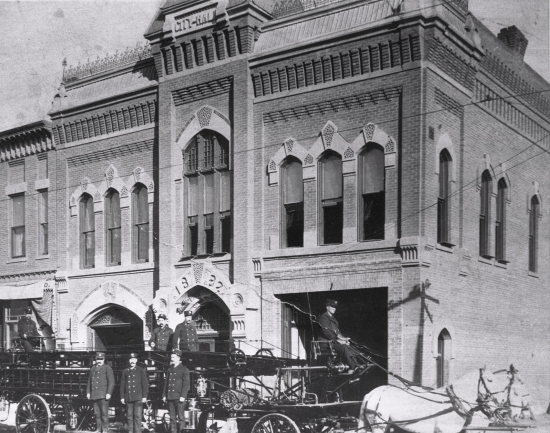
Fire Station No. 1 which housed the Hose Co. No. 1 and the Hook and Ladder Co. (shown here).
The steamer company was named the A. T. Stewart Steamer Co. No. 1, named after Alderman A. T. Stewart. The two light brown horses were purchased in St. Louis and weighed about 1,550 pounds each. The Stewart Steamer Co. was housed in the City Hall at 123 Central Main St. with the Chief's buggy. The paid firemen on the steamer were Engineer Abe Gutshall, and Firemen Cicero Weidner and James McGovern.

The Central Station at 123 Central Main St. with Engine 1 and the Chief's buggy.
The second hose company was the J. B. Orman Hose Co. No. 2, which was the name of the original hose company of the South Pueblo Volunteer Fire Dept. in 1880. It only mentions that the horses were purchased locally. The Orman Hose Co. No. 2 was housed in the old South Pueblo City Hall building at 109 E. C Street. The paid firemen for the Orman Co. were Captain Henry Jamison, Driver John Petell, and Firemen Frank M. Thomas and Joseph Schultz.
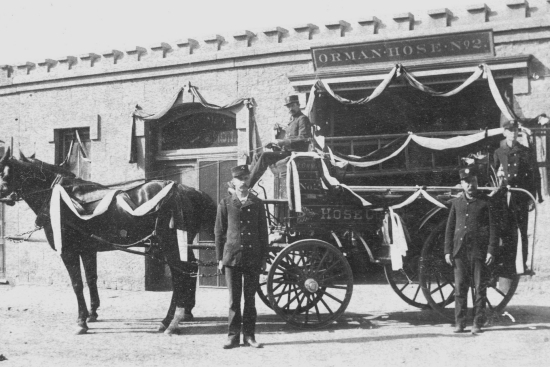
The Orman Hose Co. No. 2 at the old South Pueblo City Hall.
In 1891, Krague and Sanborn were luckily re-appointed to the chief's position for a second term. A fire chief, police chief and town marshal were often newly appointed after each mayoral election, which occured every two years. Tragically, Chief Krague was killed on July 31, 1891 while practicing with his buggy. Assistant Chief Sanborn took over as chief and finished the two year term, only to be replaced once again. This practiced continued until the creation of the city's Civil Service Commission in 1911 which solidified the positions. No fire chief had served more than 4 years until its creation.

Chief Samuel Christy was the first chief to ever serve more than four years, and would eventually serve for twenty years, the longest tenure in the fire department's history. A very forward thinking chief, he would modernize the department. When he took over, the only motorized piece of equipment was the chief's car. Within four years, Chief Christy would motorize the entire department.
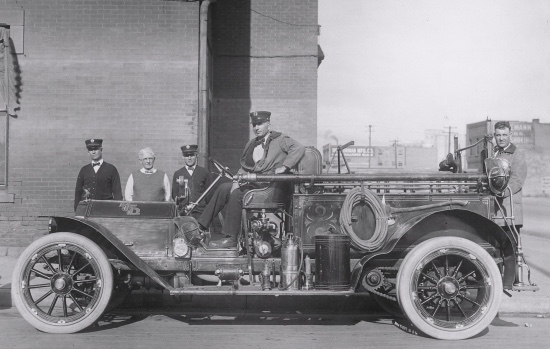
Chief Christy (second from left) with the 1911 American LaFrance Chemical Wagon, Pueblo's first motorized truck.
Christy would continue to be an innovator and help Pueblo to become one of the most progressive departments in the country under his reign. Christy allowed the firemen to unionize, even before the existance of the International Association of Fire Fighters. Christy was chief when Pueblo was a founding member of the IAFF in 1918. Christy would go on to build many of the pumper trucks that Pueblo used by putting a pump that would boost water pressure by 100 pounds on a small truck chassis. This became known as the Christy Pumper. Built by the Pueblo City Shops per the chief's instructions, the idea caught on with many municipalities, due to the low cost of building the trucks themsleves.
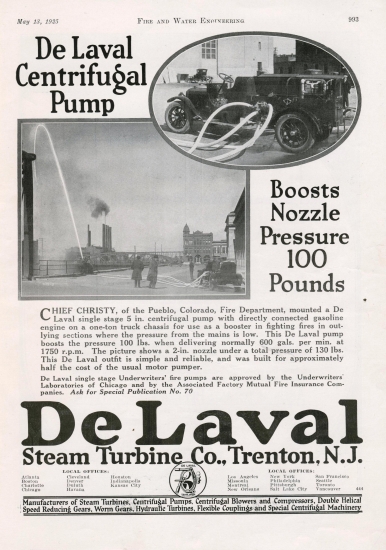
The DeLaval pump ad for the Christy Pumpers in 1925.
The Pueblo Fire Dept. was featured in many advertisements during the years Christy was chief such as the above DeLaval ad, as well as articles in several other national publications. He retired in 1931, though stayed close to the department even after his retirement. He passed the torch to his assistant chief, Luther Willis, who would continue to keep the Pueblo Fire Dept. moving in a positive direction.
Today, the Pueblo Fire Department has 10 fire stations that are strategically located throughout the city. Apparatus that are deployed from these stations include:
- 1 hazardous materials unit
- 2 ladder trucks
- 2 suppression chief vehicles
- 10 engines
- 2 4-wheel drive brush vehicles
- A rescue boat and raft
The Pueblo Fire Department provides services to mitigate the effects of a variety of emergency situations, including fires, medical emergencies, physical entrapment, and releases of hazardous materials.